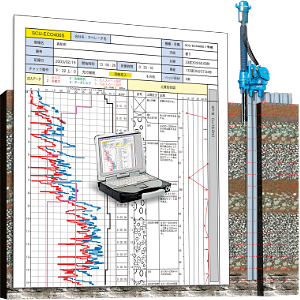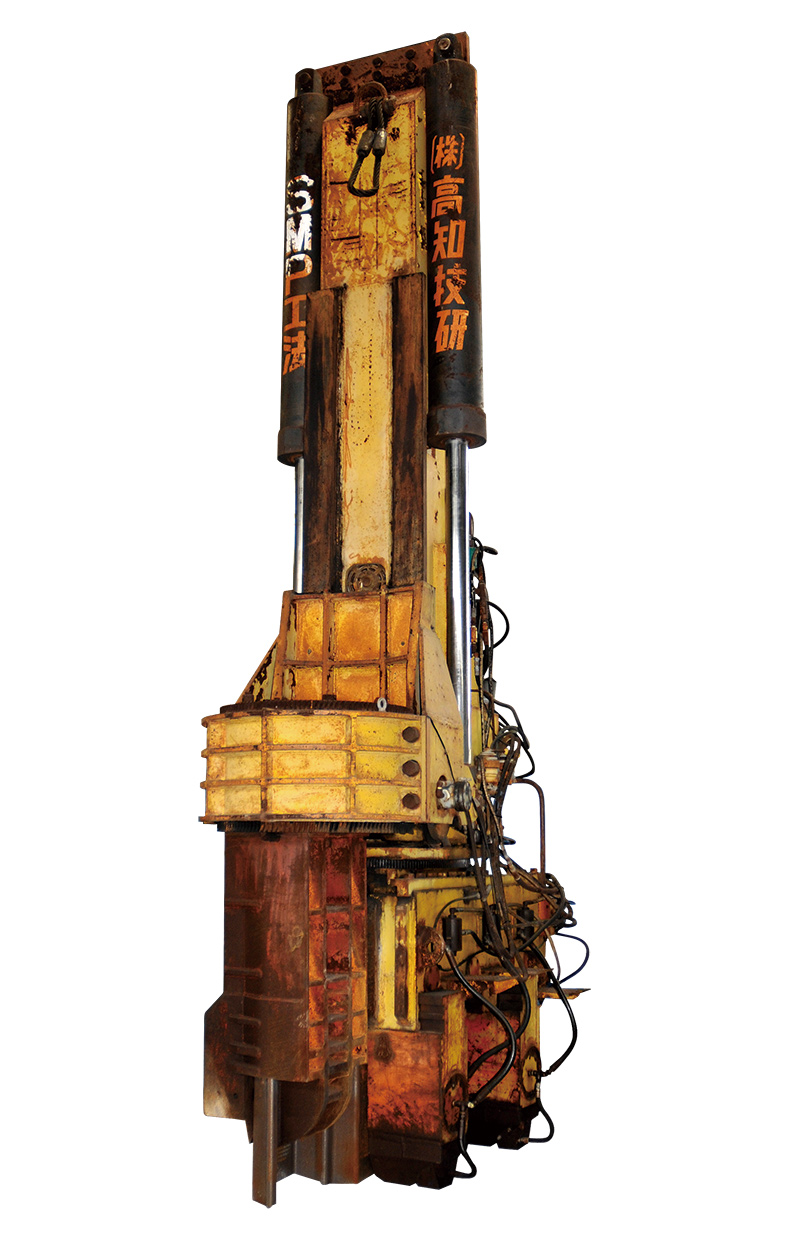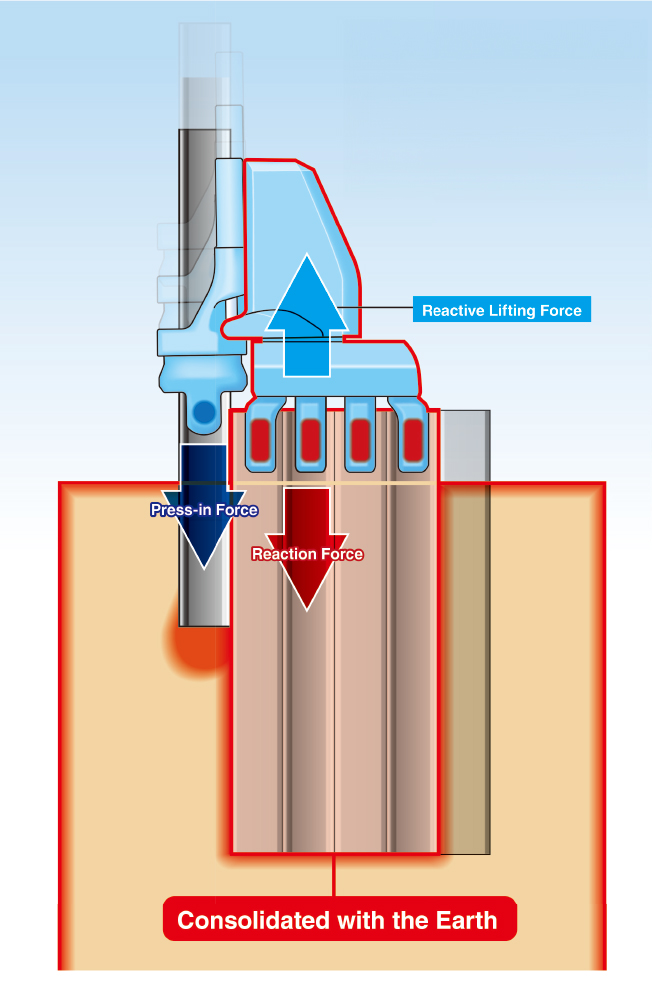What is Press-in Method?
Pile penetration methods can be classified in either dynamic penetration method or static penetration method. Dynamic penetration method inevitably generates excessive noise and vibration due to their reliance on percussive or vibratory energy. On the other hand, static penetration method won’t generate such construction pollution. If reaction force for penetration is derived only from the weight of the piling rig, the rig needs to be massive. It is not a practicable.
However, in the Press-in Method, piles are installed with static load generated from hydraulic rams. The reaction for the press-in force is derived from extraction resistance of previously driven piles. That is why a small press-in machine can generate greater force. Such compact machines can work under physically restricted work conditions.
A Reaction Force is Derived from Grasping the Earth
A press-in machine, grips the previously installed piles with its hydraulically operated Clamps. The next pile is then gripped by the Chuck at the press-in point and jacked into the ground with the static load generated by the hydralic rams.
During a press-in work, penetration resistance comprising of skin friction, toe resistance and interlock resistance occurs. The sum of these is called "penetration resistance force" and acts as a "reactive lifting force" to lift the press-in machine. Therefore, in order to push the pile into the ground, a "reaction force" greater than this reactive lifting force is required.
One method is to use the earth's gravitational force as a reaction force, but this is not practical due to the large size of the mechanical equipment. However, The SILENT PILER™, a hydraulic pile press-in and extraction mashine developed by GIKEN, grips several piles that have already been pushed into ground and have become one with the earth (completed piles), and drives the next pile using their resistance to being pulled out. In other words, by gripping the eath, the SILENT PILER can exert great force even with a light and small body.
Initial Press-in
At the beginning of any press-in work if there are no completed piles, then a "Reaction Stand" is usually used for initial piling work. The SILENT PILER is horizontally set onto the Reaction Stand and then counter weights are loaded onto the Reaction Stand. Counterweight mass is dependent on soil conditions and pile length. The first pile is then pressed-in utilising the combined weight of the machine and counter weight as a reaction force. After installing the first pile, the installed pile becomes the first reaction pile for installing the second pile. Once the Press-in Machine completely sits on top of the reaction piles, the Reaction Stand and counterweights are removed. The initial piling work is then completed.
Advantages of Pressed-in Piles
As pile is pressed into ground, a compressed soil area, so called “Pressure Bulb *1 ”, is formed around the toe of the pile being pressed-in. This pressure bulb provides the both vertical and lateral strengths on the pile structure.
*1 A pressure bulb is a bulb-shaped area formed at points in the ground where the vertical stress or ratio of vertical load to vertical stress is equal, when a load is applied to the ground.

Controlling Pile Quality
SILENT PILER can control the penetration direction of the pile being pressed-in, so that sheet piles can be accurately installed with complex pile alignments. Because piles are pressed into ground with static load, it is possible to check and control the quality of piles in order to construct high quality pile structures consistently.
Superiority of Press-in Method
An advantage of the press-in principle is being able to build completed piles that are properly supported by the earth, in addition to the following.
Environmental Protection
Static load is applied to press-in sheet piles, so there is no construction pollution like noise and vibration.
SILENT PILER is so light and compact that its extent of the piling activities can be minimised.
Safety
The piling rig hardly overturns, because it clamps previously installed files so that the rig is fixed with those reaction piles.
Pre-fabricated piles produced at the plant are pressed in directly, so high-quality completed piles can be built with peace of mind.
Speed
Multiple sets of compact machines and apparatuses can be used at the same time to greatly shorten construction period.
Speedy piling progress is available, because there are least limits in working hours even at highly restricted areas and night works.
Economy
All machines are so compact that it is not necessary to completely close active traffics.
Piles that suit the purpose are produced at the plant, for improved efficiency by streamlining the work performed on-site.
Aesthetics
With superiorities of the Press-in Method, highly accurate and high qualitysheet pile walls are available.
The performance of piles can be checked and controlled during construction, allowing high-quality completed piles to be built.
Practical Application

1st SILENT PILER™ KGK-100A
Under the Press-in Principle, in order to press pile into ground with static load, press-in machine utilises reaction forces derived from fully installed piles which are anchored to the ground and regarded as a united part of the Earth. This principle is aware and put into practical use by Mr. Akio Kitamura, the founder of GIKEN group, based on his experience at construction sites. He knew sheet piles were not extracted easily, because soil adhered to the sheet piles underground. From this fact, he got aware that a pile driver can be integrated with the Earth, if the machine grips several driven piles. And he realized that it is possible to make a noise-free & vibration free pile driver, if pile can be pressed by utilizing the extraction resistance force of the reaction piles.
It was in 1960s. Japanese economy was in the rapid economical growth period. Many upcoming major projects were facing with excessive noise and vibration at construction sites. Mr. Kitamura established Giken to challenge construction pollutions. Under his wish, he started developing the pile driver. It was July 1975 that the 1st non-noise & non-vibration hydraulic pile press-in and extraction machine, SILENT PILER (KGK-100A) was born.





